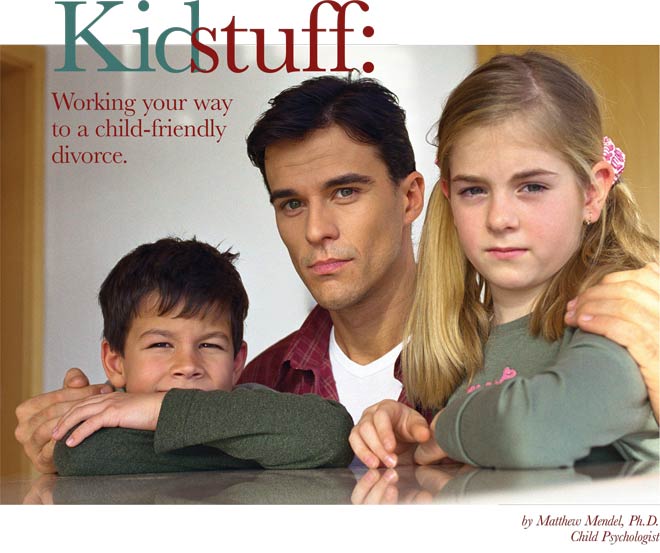
“Ask yourself,” I said to Doug, “these two questions: Can I genuinely say I am working to be the best father I can be for my child? And can I genuinely say I’m doing everything I can to encourage him to have the best relationship possible with his mother?” In my work with divorced parents, I have people like Doug and his ex-wife Susan ask themselves many variations of these questions.*
As a child and family psychologist with a special focus on children whose parents have separated or divorced, I’ve run numerous groups for children and helped develop programs used in the public schools. Many of the families I work with in private practice have been through at least one divorce. From that experience, I’ve compiled some common scenarios and pitfalls––and some recommendations for minimizing the negative impact of divorce on children.
The hard question.
“Of course,” Doug replied promptly to the first question. Parents rarely struggle with this one. Every parent wants to be a good parent; every parent wants to provide for his or her children in the manner that he or she thinks best.
The second question is far more challenging. “Well, that’s tough to do when his mom is so inconsistent. She’ll say that she’s going to be there at 5:00 to pick him up and then get there late, or she’ll say that he’s grounded for the weekend, and then let him go to a sleepover, or…” The litany of complaints will often go on for several minutes.
They may be justified, and the frustration is very real, but the question remains the same: Are you doing everything possible to facilitate a good relationship with your child’s other parent?
Encouraging such a relationship – letting your child know that you genuinely want him to love and be close to both parents––is the most loving, caring and healthy thing you can do for your child. Research indicates that the strongest predictor of child health in the aftermath of a divorce is the ability to have close relationships with both parents. Encouraging your child to love her other parent is the best thing you can do to help her cope well with the divorce.
Which brings us back to those initial questions: If the answer to #2 is “No,” then unfortunately, so is the answer to #1. If you as a parent are not doing everything you can to support your child’s relationship with his or her other parent, then you are not doing everything you can to be the best parent you can be for your child.
Take the long view.
One of the first things I tell parents is not to think of the divorce or separation as a single event, but rather as just the first in a long series of life-changing events their children will experience, which could eventually include:
- Living in 2 households
- Going back & forth between houses
- Parents dating
- Parents remarrying
- Step-parent & loyalty conflicts
- Step-siblings
- Half-siblings
The better you, as parents, can cooperate throughout all these events, the better off your children will be. If you can consistently think of your children’s needs––rather than, for example, anger and resentment toward your ex-spouse––then your children are likely to navigate the numerous challenges fairly well. If a child has to figure out how to handle changes and stressors while also attempting not to hurt mom’s feelings or make dad angry, he’ll probably be in for a very
tough time. I encourage parents to ask themselves some more questions:
Am I putting my child’s needs first?
Am I doing ___________ because this is what’s best for my child?
Or is this…
for vengeance against my ex-spouse?
to “win” against my ex-spouse?
to have rigid equality (i.e., a strict
“50-50” arrangement)
Will it help my child if I…
have an argument in front of her?
insist that she keep anything that I
bought her at my house?
Refuse to let her go to a special event
because it’s during “my time.”
What Billy felt.
Stan and Joyce have a fairly positive post-divorce relationship and communicate reasonably well about their nine-year-old son Billy. In one regard, however, they constantly butt heads: Stan, in Joyce’s view, is impossibly strict and rigid; Joyce, according to Stan, is a good-time parent, able to have fun with Billy but incapable
of providing adequate structure.
Stan and Joyce live in different states, so one of them needs to be the primary custodial parent. After the divorce, Stan naturally expected that meant him, seeing Joyce as far too much of a flake to handle the ongoing requirements of parenting. He was genuinely shocked when Billy expressed––with increasing adamancy–– his preference for living with his mother. And he assumed it was based on the fact that Billy would have fewer chores, looser rules and a later bedtime at his mother’s house.

His mother, while somewhat inconsistent and lax in rules and structure, was his primary source of warmth and affection. He described his father as nice and said that there were no real problems between the two of them. But there was also no description of physical affection or tenderness.
In other words, from his father he got clear structure and a solid, appropriate sense of expectations and responsibilities; from his mother, he received comfort, affection and nurturance.
When the three lived together in the same household, Billy was provided with all the necessary components of good parenting. With the divorce, these components were split between the households. Neither is better than the other: both are absolutely critical to raising a healthy child.
Parts of a whole.
Often in post-divorce families, these two essential parts become separated and polarized, so that one parent becomes the fun or “Disneyland” parent, while the other takes on the role of disciplinarian. Over time, the parents move more and more to their respective poles.

As each learned to recognize and value the role the other parent played with Billy, both felt able to accept and encourage the relationship Billy had with the other parent. Stan no longer saw Billy’s expressed preference for living with his mother as a rejection of him. Perhaps most important, Stan began to work on developing the fun, affectionate aspect of his relationship with his son, which had been too long neglected––Joyce worked on establishing a clearer, more consistent set of rules and responsibilities for her household.
Through the eyes of a child.
Children are self-centered beings. I say this with no negative judgment, and with enormous affection. It’s developmentally appropriate and normal that children, especially young children, think of themselves and their needs first and foremost. This fact can go a long way toward guiding parents in making good choices about helping their children through this enormously stressful time.
Children need to be safe and to know they’ll be safe. They need to know their basic needs will be provided for, and continue to be met. When parents separate, it challenges a child’s basic confidence in the permanence of the family. Young children in particular never dream that this could happen to them.
Because of their developmentally appropriate self-centeredness, the questions children ask essentially come down to: What will this mean to me? If mom could leave dad (or vice-versa), could she (or he) leave me? If they break up or stop loving each other, could that happen to me? Could they stop loving me? These basic needs and fundamental fears serve as a guide for the sorts of reassurances parents need to provide:
I will always be your mommy.
Daddy will always be your daddy.
We will always love you; that will never change.
Mommy & daddy will be living in two different places, and that’s because of problems mommy and daddy have (or because mommy and daddy can’t get along), but we will both always love you, and always be there for you, and always take care of you…
These messages work equally well for moms and dads. Bear in mind that any important message needs to be given repeatedly. Children take in only a small portion of what you say, especially when they’re in a state of emotional distress and over-stimulation. Details about divorce and the changes to follow should come in small doses, and important facts need to be repeated several times over a period of days and weeks.
Who’s the decision maker?
Teresa and Will, ex-spouses with a very amicable relationship, needed help after a change in their children’s living arrangements. From the outset, their older daughter Samantha had wanted to live with mom, while their younger child, Adam, wanted to live with dad. Things got more complicated when Teresa moved out of state. Shortly after the move, Adam said that he, too, wanted to live with mom. The parents agreed to adjust the living situation so that both children lived with mom and spent one weekend a month and vacation times with their father. But then Adam said he wanted to go back to live with his father. He also seemed increasingly anxious and distressed, and became more and more withdrawn from his peers.

Giving this kind of choice to a child leads almost inevitably to feelings of guilt and anxiety. Adam felt enormously conflicted, believing that if he chose to live at dad’s, mom would be hurt––and if he chose to live
at mom’s (especially since Samantha had already made that choice) dad would feel rejected and abandoned. Either way, he would be responsible for hurting one of the people he loved most in the whole world. That is simply an unfair burden to place on a child.
The appropriate stance for parents to take in such situations is to listen to their children, to work on understanding their feelings, desires, wishes and frustrations, to let their children know that these feelings have been heard, and then to let the children know that the parents will together make an appropriate decision.
In this case, the parents decided that Adam would stay with his mother rather than making a change in the middle of the school year. He would go, as planned, to stay with his father for the first month of summer vacation. Then mom and dad would make a decision about the most appropriate setting for Adam for the following school year. Adam’s anxiety level and distress lessened almost immediately. He no longer felt that he had to choose between parents, a choice which had been psychological torture for him.
Livable living arrangements.
What is the optimal post-divorce living arrangement? What is the best plan for where to live and how much time to spend with each parent? The answer, quite simply, is that there’s no such thing as an optimal plan.
I have seen any number of arrangements work out splendidly – including several that, quite frankly, I thought were rather silly or unwieldy. I’ve also seen numerous arrangements that seemed elegant and practical on paper fail miserably. What’s the best predictor of success? Having both parents on board with the plan. If they, together, can come up with an arrangement that’s reasonable and they can live with, chances are it will work pretty well. This isn’t because of any particular virtue or flaw in the plan, but because both parents will back the plan and – at least for the most part – resist letting anger or resentment undermine it. That sort of support goes a long way toward making any plan, even the most seemingly awkward, work well.
Of course, there are certain guidelines that may help you arrive at an effective time-sharing arrangement. The best plans have the backing of both parents and are at least roughly consistent with the temperaments and developmental stages of the children.
• Think of it as time-sharing, not living with one parent and visiting the other. This is not so much about language as point of view. Often, the parent who does not have primary custody, sees himself or herself as a “visiting parent,” or is constantly on guard against anyone seeing him or her as such. It is essential for such parents to remind themselves that they play an integral role in their children’s lives, even if those children are spending a majority of nights at the other parent’s home.
• Remember that children’s needs change as they get older. A plan that works great when a child is three years old may be totally ineffective when she is eight, and a still different plan may be needed when she is 16.
• Generally speaking, pre-schoolers do best with shorter, more frequent contact, often not involving overnights.
• Elementary-school age children respond well to somewhat less frequent contacts of longer duration, including weekends, overnights and longer times during vacations. (It’s among this group that the “classic” post-divorce arrangement of living with one parent and spending every other weekend along with a mid-week visit with the other parent is probably best suited.)
• Regularly scheduled, consistent contact may be impractical for adolescents, because of the tremendous importance of peer relationships at that age, their increased involvement in scheduled extra-curricular activities and their ability to drive. Less frequent overnights, briefer contacts such as dinners or an outing, and occasional longer get-togethers (such as a week or two during summer vacation) often suffice.
• It is especially important for parents of teenagers to be flexible and able to adapt to their children’s schedules. Perhaps most critically, parents must recognize that when their teen says he or she doesn’t want to come for the weekend because of peer or extra-curricular activities, this is developmentally appropriate, even healthy, and not a rejection of that parent.
• It is tremendously important for a child’s well-being that the non-custodial parent remain active in his or her life. This can certainly be a challenge, especially when there’s geographic distance involved. It isn’t the frequency or duration of contact that is essential, but its predictability and consistency. A child needs to know that even though, for example, mom lives in a different state, he will see her at Christmas and over the summer, will talk by phone and/or e-mail regularly and––most important––she will always love him and always be his mom.
• The non-custodial parent needs to assure him––or herself that despite the fact that the children do not live with him or her most of the time, he or she still has an enormous influence upon the children, and plays a central role in his or her children’s lives.
• The worse the relationship between the parents, the simpler the time-sharing arrangement should be, since complex arrangements require more and better communication between parents.
• Children often misbehave or display distress right after they return from time at the other parent’s home. This does not necessarily mean there is a problem with the arrangement or the other parent did something wrong. Transitions are stressful; it takes time for children to adjust and reacclimatize to another home.
• Whatever arrangement is in place, try not to think of your child’s time as “my time” versus “the other parent’s time.” All of it is your child’s time. Do your best to make it a good, happy, healthy time, regardless of who your child is with.
Will boys always be boys?
Logan is one of several dozen young adolescent boys who have all dealt with remarkably similar issues. In each case, the parents divorced when the children were young, and the children lived with the mother and went to see their father with varying frequency. In Logan’s case, he and his younger sister Beth went to their father’s home every other weekend, and had dinner with him every Wednesday. By all accounts, this arrangement had worked marvelously for several years.

his father.
“Maybe,” I suggested to Logan’s mother, “that’s exactly what’s needed.” Not because she was anything but an excellent mother, and not because of any major problems inherent in the relationship between her and Logan, but simply because Logan was a boy and entering adolescence.
I’ve seen this dynamic time and time again: a boy who has lived primarily with his mother since his parents’ divorce begins to act out or misbehave as he enters puberty or early adolescence. While this may appear simply to reflect the impact of puberty and the consequent hormonal and psychological changes, in post-divorce families the dynamics are often somewhat different. In Logan’s case his oppositional and defiant behaviors occurred almost exclusively at his mother’s home. So the decision was made to have Logan move to his father’s home, and the situation improved almost immediately. Logan’s relationship with his mother reverted to its previous positive state.
Fathers and sons.
Logan’s issues revolve around the developmental tasks of adolescence. If we think of this as a period of learning to be an adult––and for a boy, as a period of learning to be a man––then the most important role model is his father. It is from his father that he gets the most crucial messages of what it means to be a man.
A boy doesn’t have to live with his father in order for dad to play a critical role in his development. Nevertheless, many boys in post-divorce families seek out closer relationships (and often increased contact) with their fathers as they approach adolescence. Sometimes this is done explicitly: a boy may speak with his parents about wanting to see dad more, or parents may discuss the possibility of shifting the primary residence from mom’s to dad’s home. More often, the scenario unfolds as in Logan’s case: a boy who has lived with his mother since the divorce begins to act out in various ways as he approaches adolescence.
Keep in mind that the situation can occur with the genders reversed: a girl who has lived with her father may seek increased contact with her mother as she reaches puberty; in our society, however, situations like Logan’s are far more common.
With the benefit of hindsight, parents can see that their son’s behavior may have represented a developmental need, and that such needs will continue to change over time. Unfor- tunately, this process can instead become “evidence” of a mother’s unfitness, or a father’s parenting skills––in the midst of a child’s changing behavior, it’s hard to look at things dispassionately. Which is one reason why such changes are good indicators of appropriate times to seek counseling.
Patterns of complaint.
Felicia, divorced for three years, was concerned about her twin daughters’ adjustment to their post-divorce living arrangement. Both girls had become increasingly negative about circumstances at their father’s home. Over the years, they complained more and more about (among other things) his temper, and the amount of time he spent on the computer instead of with them. She wondered about seeking a decrease or discontinuation in their visits with their father.
Jordan, their father, presented a mirror image of what their mother said. His daughters complained more and more about their mother. They used to describe nice sit-down dinners together; now everything was rushed, and she spent all her free time on the phone with her boyfriend or dragging them off to see him, rather than spending time with just them.
The girls, Danielle and Tanya, proved to be well-mannered, high-spirited 12-year olds, who did well in school and other activities and were very well liked by their peers. They seemed to be thriving in most areas of their life. When asked about their father, they were actually relatively positive about him.
Yes, they had some complaints: he could get snappy at them, especially at the end of the day if they were slow about beginning their homework; he did spend time on the computer when they wished he would play with them. But balanced against those complaints were numerous comments about the positive and loving interactions they had with him. When asked about their mother, they gave a similar, generally positive description, mixed with some negatives. They liked things better before she got a boyfriend; he was pretty nice, but they don’t get to spend enough time with just their mom.
This is a common scenario in post-divorce families––especially when one parent harbors resentment, anger or suspicion about the other. It’s an insidious pattern, one that develops without conscious intent on the part of parent or child. Essentially, children quickly learn that a parent likes it when they complain about the other parent. The complaints are reinforced when the parent responds with far more interest than he or she does to positive comments. The more the child complains, the more the parent responds ––with interest, sympathy or reward. It can go something like this:
Week One:
Child: I had a great time this weekend at mom’s.
Dad: (Disinterestedly) Oh, that’s nice.
Week Two:
Child: I had a lousy time this weekend at mom’s.
Dad: Oh, why? Tell me about it. Did your mom do something that upset you? Here, let me do something special to make up for that…
While maybe a little over the top, this example makes clear the dynamic that can develop between a child and the warring parents. And it shows how the negative comments can naturally increase. The child isn’t intentionally being manipulative; kids say what they think parents want to hear. Sometimes, a child will make virtually identical complaints about each parent. If this goes on too long, both mother and father may reach the conclusion that the other is a terrible, unfit parent and that the child wants to––and should–– spend all of his or her time with them, and discontinue contact with the other parent.
The lesson here is fairly simple: Pay at least as much attention, and provide at least as much feedback, when your child says something positive about the other parent as when he or says something negative. Most important, the message to your child needs to be that what makes you happy is for your child to be happy, wherever he or she is.
And that really leads to the ultimate question to ask yourself in any situation:
Can I genuinely say that what I want is for my child to be happy, both when he is with his other parent and also when he’s with me?



